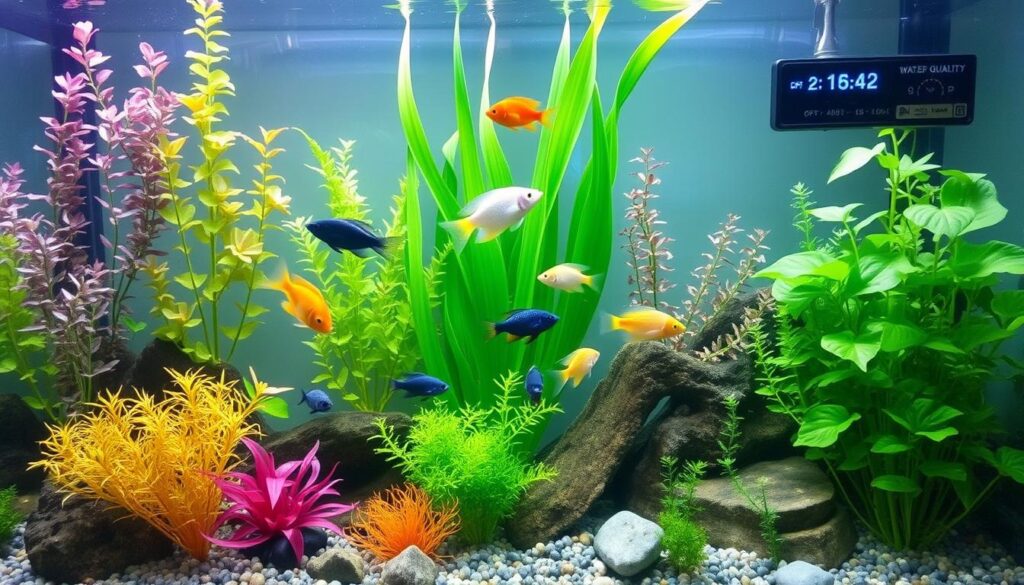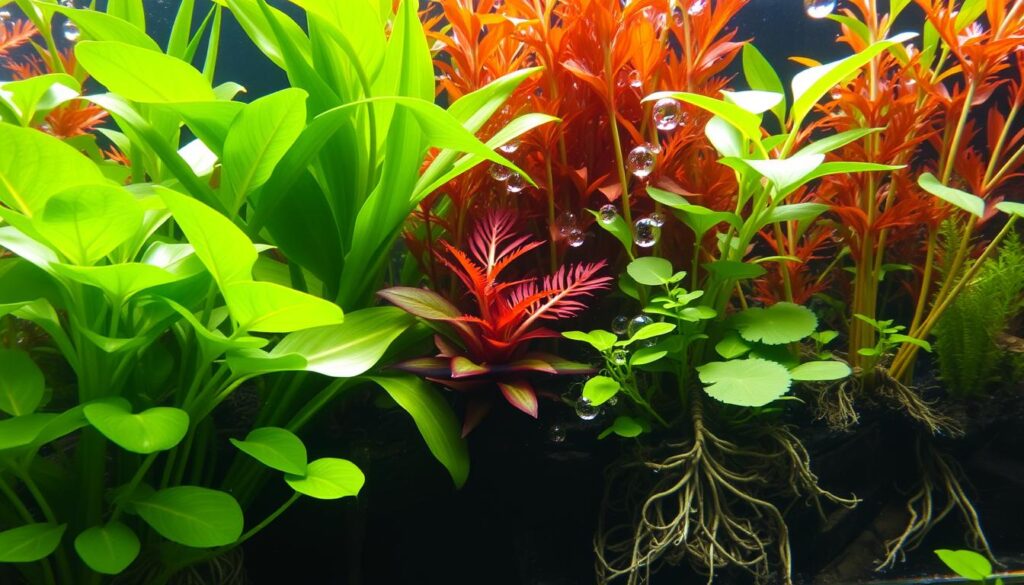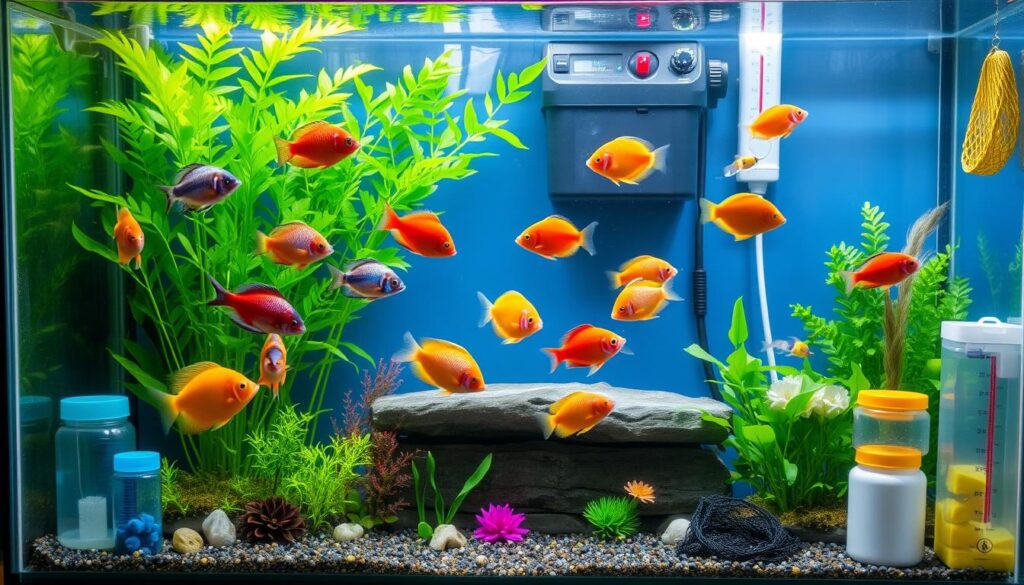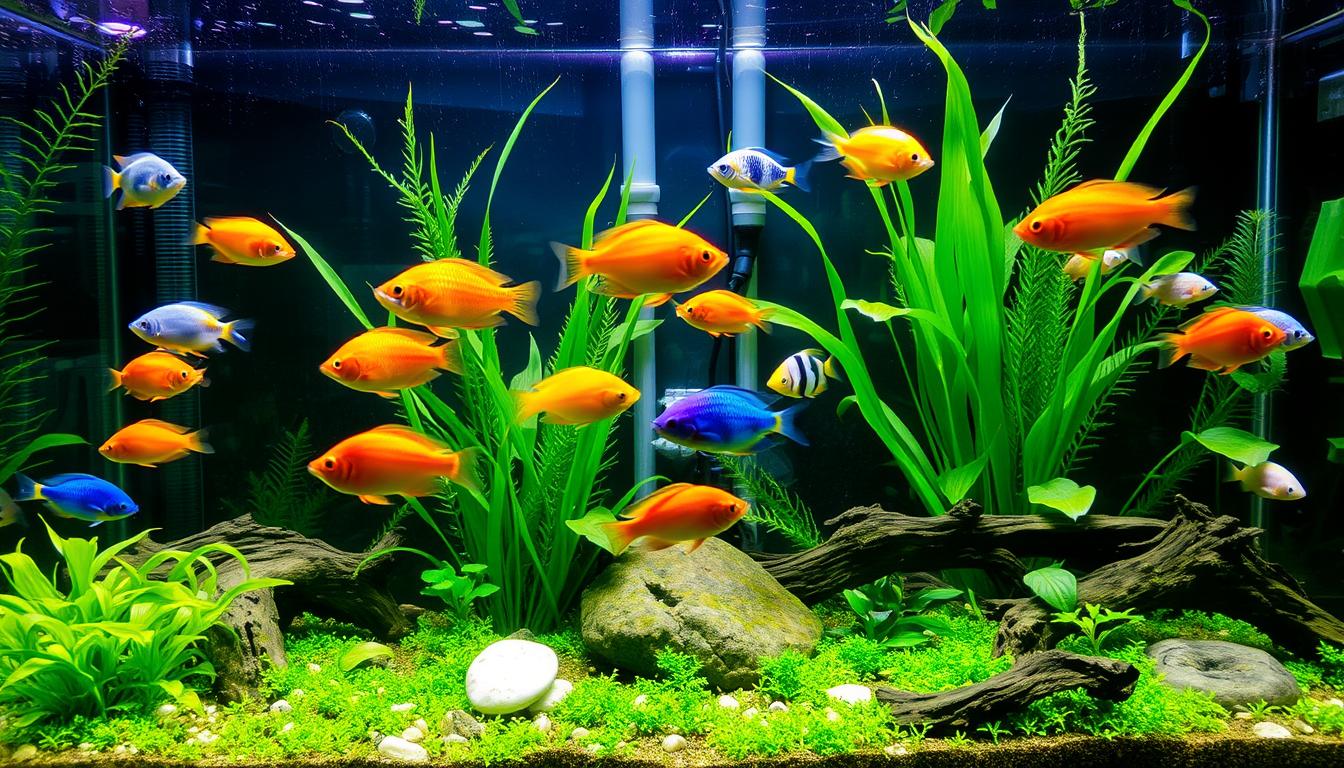Proper care of a freshwater aquarium is key to a thriving aquatic world. As a beginner, knowing the basics is crucial. This includes setting up the tank, choosing the right equipment, and keeping water quality optimal. For more tips on aquarium cleaning, check out freshwater aquarium care tips to keep your fish healthy.
Key Takeaways
- Regular water testing is vital for maintaining optimal water quality in freshwater aquarium care.
- Choosing the right equipment, such as filters and heaters, is essential for beginner aquarist tips.
- Freshwater aquarium care involves a deep understanding of the nitrogen cycle and its impact on water quality.
- Proper freshwater aquarium care requires a balanced approach to lighting, temperature, and water circulation.
- Researching and selecting compatible fish species is critical for creating a harmonious aquatic environment.
- Establishing a regular maintenance routine is essential for maintaining optimal water quality and ensuring the health of your fish.
Understanding the Basics of Freshwater Aquarium Care
Starting as a beginner aquarist means learning the basics of freshwater aquarium care. You’ll discover different types of tanks, like community and species-specific ones. By following key maintenance tips, you can make a great home for your fish and plants.
Setting up your tank right is key. You’ll need a good filter, heater, and the right lighting. Regular water changes and keeping an eye on water quality are also crucial. Learning terms like the nitrogen cycle and water hardness is important for your fish’s health.
Here are some important things to think about when starting your aquarium journey:
- Choosing the right size and type of tank for your space and needs
- Selecting compatible fish species and plants
- Learning about the nitrogen cycle and how to maintain good water quality
By following these tips and doing your research, you can create a stunning freshwater aquarium. It will bring you joy and relaxation for many years.
Selecting the Perfect Tank Location and Size
Choosing the right tank location and size is key in aquarium care. The tank’s spot can impact fish health and the aquarium’s look. Think about sunlight, temperature, and easy access for upkeep when picking the best spot.
Some important things to think about when picking the tank’s location include:
- Proximity to a power source
- Stability and levelness of the surface
- Distance from direct sunlight and heat sources
For tank size, consider the space, fish number, and aquarium type. A good rule is to pick a tank that’s at least 20 gallons for small ones. For bigger ones, go for 55 gallons or more. This size helps keep the fish healthy and makes care easier.
By following these tips and considering these factors, you can make a great aquarium. It will be a source of joy and calm. Always put your fish’s health first. If you’re unsure, ask experts for help.
Setting Up Your Water Chemistry Parameters
Keeping your aquarium’s water quality right is key for your fish’s health. You need to know about pH levels, water hardness, and the nitrogen cycle. Adjusting these can make your aquarium a safe and healthy home for your fish.
Every fish is different, and they all need specific water conditions. If you don’t meet these needs, your fish might get sick or even die. Knowing about water chemistry helps you make the right choices for your aquarium’s water.

First, learn the basics of water chemistry. This includes pH levels, which show how acidic or alkaline the water is. Also, water hardness shows the mineral levels. And don’t forget the nitrogen cycle, which breaks down waste and keeps nutrients balanced.
Understanding pH Levels
pH levels are very important for your aquarium’s water. Most fish like water that’s slightly acidic to neutral, between 6.5 and 7.5. But some fish need different pH levels, so check what your fish need.
Managing Water Hardness
Water hardness is also key. It’s about the minerals like calcium and magnesium. Most fish like moderately hard water, but some need softer or harder water.
Nitrogen Cycle Basics
The nitrogen cycle is vital for keeping your water clean. It turns ammonia into nitrite and then nitrate, which is safe for fish. Knowing the nitrogen cycle helps you keep your aquarium water healthy for your fish.
Choosing the Right Filtration System
Keeping your aquarium healthy starts with a good filtration system. It removes waste and excess food, keeping the water clean. Regular filtration system maintenance is key to its efficiency.
Think about your aquarium’s size and the fish you have when picking a filter. There are mechanical, biological, and chemical filters. A mechanical filter catches solid waste. A biological filter breaks down organic matter. A chemical filter cleans the water of impurities and toxins.
Consider these when choosing a filter:
- The size of the aquarium
- The type of fish being kept
- The level of maintenance required
- The budget for the filtration system
Choosing the right filter and maintaining it well keeps your aquarium clean and healthy. This ensures your fish stay well.
Mastering Proper Tank Lighting
Lighting is key for the health of fish and plants in your tank. Finding the right balance between natural and artificial light is crucial. Natural light can cause algae and uneven lighting, but artificial light offers control.
Creating a day and night cycle in your tank is important. Use a mix of lighting fixtures and timers for this. LED lights, for example, are energy-saving and don’t get hot, helping to set up a day-night cycle.
Natural vs Artificial Light
Natural light is good for tanks, but you need to control it. Too much can cause algae, while too little can harm plants. Artificial light, however, lets you manage the environment better. With the right lighting schedule, you can ensure healthy growth.
Lighting Duration Guidelines
Guidelines for lighting time are important. Aim for 10-12 hours of light and 12-14 hours of dark each day. Adjust this based on your fish and plants’ needs. Following these guidelines helps create a thriving tank environment.
Creating the Perfect Aquascape
Aquatic plant care is key to a thriving and beautiful aquarium. When designing your aquascape, think about the plants, rocks, and decorations you’ll use. A balanced setup helps keep water quality high and makes a healthy home for fish.
Some important things to consider for a perfect aquascape include:
- Picking the right plants for your tank, considering their size, growth, and light needs
- Choosing rocks and decorations that match your plants and give fish places to hide
- Creating a layout that lets water flow well and avoids dead spots
By following these tips and caring for your plants, you can make a stunning aquascape. Make sure to pick plants that fit your tank’s water and light conditions. With the right care, your aquascape will be a beautiful and healthy space for your fish.

Caring for your aquascape is a continuous job. Keep an eye on water quality, trim plants, and adjust as needed. With the right knowledge and effort, you can make an aquarium that everyone will admire.
Selecting Compatible Fish Species
Choosing the right fish for your aquarium is key. You should think about their swimming habits, how they act in groups, and how big they can get. A fish feeding guide can help you understand what they eat. This way, you can make your aquarium a happy and healthy place for all.
Some fish are very calm and can live together peacefully. These include peaceful community fish like tetras, gouramies, and livebearers. Schooling fish, like barbs and rasboras, do best in groups of six to ten. This helps them feel less stressed and less aggressive.
Adding bottom dwellers, such as catfish and loaches, can help clean up the bottom of your tank. When you bring new fish home, it’s important to follow a fish feeding guide. This helps them adjust smoothly and reduces stress. By picking the right fish and introducing them carefully, you can make your aquarium a thriving and balanced home for all.
Maintaining Optimal Water Quality
Keeping the water in your aquarium healthy is key for your fish and plants. You need to check the water’s pH, ammonia, nitrite, and nitrate levels often. This helps spot problems early.
Changing the water in your tank is also important. You should take out some old water and add fresh, clean water. How often you do this depends on your tank’s size, how many fish you have, and how much waste they produce. Proper water quality management keeps your tank healthy.
Here are some tips for keeping your water quality top-notch:
- Check water parameters often
- Change the water regularly
- Keep the biological balance right
- Don’t overfeed, as it can harm water quality
By following these tips and keeping up with water quality, you’ll have a happy and thriving aquarium.
Remember, keeping the water quality right is a continuous job. With regular care, you can have a stunning and healthy aquarium for many years.
Regular water changes and proper biological balance are essential for maintaining optimal water quality and preventing water quality issues.
Establishing a Feeding Schedule
To keep your fish healthy, setting up a good feeding schedule is key. A fish feeding guide can show you how often and how much to feed them. It’s important not to overfeed, as it can harm the water quality.
There are different types of food for fish, like flakes, pellets, and live or frozen foods. Each has its own benefits and drawbacks. A fish feeding guide can help you choose the right food for your fish.
Types of Fish Food
- Flakes: a convenient and easy-to-digest option
- Pellets: a more nutrient-rich option that can be fed to larger fish
- Live or frozen foods: a great way to provide variety and stimulate your fish’s natural hunting instincts
How often you feed your fish matters too. Most fish need to be fed 2-3 times a day. Make sure they can eat it all in a few minutes. Overfeeding can hurt your fish and the water quality. By following a fish feeding guide and watching your fish’s eating habits, you can keep your aquarium healthy.
Managing Aquatic Plant Health
Aquatic plants are key to a healthy aquarium. They give oxygen, food, and shelter to fish. Taking good care of them is crucial for a balanced ecosystem. Fertilization is a big part of this care, as it gives plants the nutrients they need.
Here are some tips for aquatic plant care:
- Use a balanced fertilizer with nitrogen, phosphorus, and potassium.
- Keep an eye on water parameters for the best plant growth.
- Prune or propagate plants to keep them healthy and looking good.
Regular upkeep is also important for aquatic plant care. This means checking water quality, controlling algae, and making sure there’s good lighting and water flow. By following these steps, your plants will flourish, making your aquarium beautiful and healthy.
Remember, aquatic plant care is a continuous effort. With the right knowledge and care, you can make your aquarium a stunning showcase of aquatic plants.
Implementing Regular Maintenance Routines
Keeping your aquarium healthy is key. A regular routine helps keep it clean and stable. It also makes sure your fish are happy. One important aquarium maintenance tip is to make a schedule and follow it.
For your aquarium to stay in great shape, do different tasks daily, weekly, and monthly. These include checking water, cleaning gravel, and changing filter media. Here are some essential tasks for your aquarium maintenance tips routine:
Daily Tasks
- Monitor water temperature and pH levels
- Check for signs of stress or disease in your fish
- Feed your fish according to their nutritional needs
Weekly Procedures
- Clean the gravel and decorations
- Replace 10-15% of the water with fresh, dechlorinated water
- Check and replace filter media as needed
Monthly Maintenance
- Perform a partial water change of 25-50%
- Clean the filter and check for any blockages
- Inspect the aquarium for any signs of wear or damage
By sticking to these aquarium maintenance tips and a regular routine, your aquarium will stay healthy. Always put your fish’s health first. If you’re unsure, don’t hesitate to ask for advice.
Preventing and Treating Common Fish Diseases
As a beginner aquarist, knowing about common fish diseases is key. Beginner aquarist tips stress the need for a clean, healthy tank. This means regular water changes, good filtration, and a balanced diet.
Common diseases include ich, fin rot, and swim bladder disease. These can come from bad water, stress, or bacteria. Watching your fish closely and acting fast if they get sick is crucial.

For instance, quarantining new fish before adding them to your main tank helps stop disease spread. Also, a varied, nutritious diet boosts their immune system. By following these tips, you can ensure a healthy home for your fish.
- Regular water changes
- Proper filtration
- Balanced diet
- Quarantining new fish
Preventing fish diseases is always better than treating them. By following proper beginner aquarist tips and maintaining a healthy environment, you can help keep your fish happy and healthy.
Troubleshooting Water Quality Issues
Even with regular care, water quality problems can pop up in a freshwater aquarium. It’s key to manage water quality well to stop disease and keep a healthy space for fish and plants. Keeping an eye on water parameters is vital to catch issues early.
Common problems include algae, ammonia spikes, and cloudy water. Knowing why these happen and fixing them is crucial. For instance, too much algae can mean too many nutrients, while ammonia spikes might mean bad filtration or too much food.
Algae Control
Keeping algae in check is a big part of water quality management. This can be done by changing water often, watching nutrient levels, and using algae products. Also, making sure lighting is right and not feeding too much helps stop algae.
Ammonia Spikes
Ammonia spikes are harmful to fish and other sea creatures. To avoid them, keep your filter working well, don’t overfeed, and check water often. If you do get an ammonia spike, you need to act fast to fix the water quality.
Cloudy Water Solutions
Cloudy water can come from bad filtration, too much food, or bacteria. To clear up cloudy water, find out why it’s happening and fix it. This might mean changing the filter, eating less, or using water clarifiers.
Taking Your Aquarium to the Next Level
If you’ve got the basics down, it’s time to take your tank to the next level. Invest in betterfiltration system maintenance and try out specialaquarium lighting schedules. This will make your tank a vibrant and thriving underwater world.
Think about getting a top-notch canister filter or a surface skimmer. They’ll help with water flow and make it clearer. Try different light setups to help your plants grow best. With some creativity and hard work, your tank will be a beautiful display of your skills.
The secret to improving your aquarium is to keep learning and trying new things. Stay curious, join online forums, and be open to new ideas. The journey of aquarium keeping is endless, and you can create a truly unique and amazing underwater space.
FAQ
What are the different types of freshwater aquariums?
There are two main types of freshwater aquariums. Community tanks have many fish species that get along. Species-specific tanks focus on one type of fish.
What are the essential equipment pieces for a freshwater aquarium?
You need a tank, filter, heater, lighting, gravel or substrate, and decorations for a freshwater aquarium.
What is the nitrogen cycle, and why is it important for aquarium health?
The nitrogen cycle is when good bacteria turn fish waste and food into safer stuff. It’s key for keeping the water clean and the fish healthy.
How do I choose the right size tank for my aquarium setup?
Pick a tank size based on how many fish you’ll have and how much space you have. A good rule is 1 gallon of water per inch of fish.
What are the different types of filtration systems, and how do I choose the right one?
There are mechanical, biological, and chemical filters. The best one for you depends on your tank size, fish number, and ecosystem needs.
How do I create the perfect lighting conditions for my aquarium?
Good lighting is vital for your fish and plants. Think about the type of lighting, how long it should be on, and what your fish and plants need.
What are the key considerations when selecting compatible fish species?
Choose fish that match your tank size, water needs, and how many fish you want. This makes a happy and healthy aquarium community.
How do I maintain optimal water quality in my aquarium?
Keep water quality up by testing and adjusting pH, hardness, and ammonia. Regular water changes and a good filter are also key.
What is the best way to establish a feeding schedule for my fish?
Feed your fish the right amount and at the right times. Don’t overfeed, and give them a varied diet to keep them healthy.
How do I care for the aquatic plants in my aquarium?
Take care of plants by fertilizing, pruning, and controlling algae. Make sure they get enough light and have the right water conditions.
What are the most common fish diseases, and how can I prevent and treat them?
Common diseases include ich, fin rot, and bacterial infections. Keep your tank clean, quarantine new fish, and treat diseases quickly to prevent and manage them.

